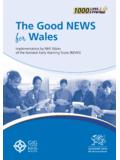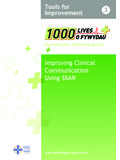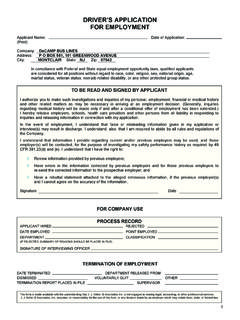Transcription of Examples of using the Model for Improvement and PDSA ...
1 1 Examples of using the Model for Improvement and PDSA cycles in dental services Example 1 Context: Practice Manager in GDS practice Problem: The practice manager was concerned at the number of patients who failed to attend their appointments (FTA). The practice is in a socially deprived area where there is limited access to primary dental care, and high levels of dental disease. Over the years the practice had tried to tackle the FTA rate, but none of the changes had been sustained. To reduce the number of patients who fail to keep their dental appointments without notifying the practice Engaging staff: The practice manager raised the issue at a team meeting.
2 Some staff felt it was to be expected and they dealt with it by double booking a number of clinics, but one dentist and her nurse agreed to try to tackle the issue. The patient perspective: The main impact was on the practice. Failed appointments waste time and cost the practice financially. However they also mean that other patients can t be offered appointments as quickly as they want, and double booking can mean stress for staff and extra waiting for patients if everyone attends. 2 The dentist / nurse / practice manager team decided to measure the extent of the problem. They agreed it feels like a problem but didn t know the exact extent of it.
3 They started by agreeing what constitutes a failed appointment and then decided to keep a simple paper record of DNAs including - the patient s demographic details - are they new patients to the practice - what treatment they were due to have - time of failed appointment - any previous failed appointments The data was collected for 2 weeks and then analysed. 15 patients FTA but there were no apparent trends or common factors. The biggest impact was when patients had long appointments or in one case when a family of 4 FTA. The nurse agreed to phone the patients to ask them whether there was a particular reason they had FTA. The phone calls showed 5 patients had forgotten they had an appointment, of which 3 were new to the practice 4 had transport problems 2 were not well at the time of their appointment 4 could not be contacted because the phone numbers on file were incorrect.
4 The team decided to implement changes and continue to keep data so they could see whether the changes had improved the situation Changes suggested 1. phone patients with appointment length 30 minutes or over 2. phone new patients to remind them of their appointment 3. To ask all new or recall patients for their phone number to ensure correct number in the notes, 4. to put a reminder notice by reception to ask patients to tell receptionist if their number had changed 3 Strategy for change: For a week the practice manager phoned patients the day before their appointments. In some cases the patients were grateful to be reminded but others were busy when the call was made.
5 The team decided to change their approach 1. To ask patients if they would prefer a reminder text or phone call 2. Continue with patient groups as per 1 and 2 above but add in family groups of 2 people or more 3. To contact patients 48 hours in advance rather than 24 hours Measurement for Improvement : how did / would you measure the effects of your changes? Record kept of patients send reminder texts or phoned Data kept on patients FTA and whether they had been sent texts or phoned. Effects of your changes: describe the impact of your changes on your patients and the staff involved (or what you think the impact should be)? How far did these changes resolve the problem that triggered your work?
6 The number of FTAs reduced among the group who were contacted prior to the appointment Anonymised FTA data displayed in waiting room All patient advised about the importance of keeping appointments or cancel with as much notice as possible. New patients given a card advising that if they FTA they will not be sent another appointment, and may have to wait some weeks before they can be seen again Patients who repeatedly FTA or arrived late were asked if they use public transport. If they did appointments are now booked to allow for busy times etc. Lessons learned: It s not possible to eliminate FTAs, but reminder communications have helped to reduce them and patients generally appreciate them.
7 By contacting 48 hours in advance it s been possible to fill any unfilled appointments if patient cancel when reminded, or use them for unscheduled emergencies 4 Example 2 Context: Dental team in the practice waiting room Problem: A patient attended the practice for treatment. She brought her elderly Mother with her who was suddenly taken ill in the waiting room and subsequently died. The dental team did all they could to save her. The incident included dealing with the relative who was a dental patient, and others in the waiting room. An ambulance was called but there were problems phoning 999 and it then took 20 minutes for the ambulance to arrive.
8 A few days later one team member became extremely distressed and very worried that she hadn t done all she could to save the woman. Other team members said that they were also upset, but other felt the team had done really well in applying their CPR training. The team had not had any form of debrief or chance to discuss the incident so they decided to discuss what had happened and whether there was anything they could have done differently 1. Allow team members to discuss the incident and how it made them feel 2. To identify what the team did well 3. To identify any improvements to help the team deal more easily with a patient emergency Engaging staff: The whole practice team was included in the discussion at a team meeting.
9 Not simply team members directly involved in the incident The patient perspective: The patient was understandably very distressed when her Mother was taken ill, but she was looked after by a dental nurse who made her tea and kept her informed of what was happening. She was never left on her own and was allowed to use the practice phone to call her husband and son. She was told when the ambulance crew arrived and what hospital her mother had been taken to. She was given all her mother s belongings and the dental team made sure she and her husband had transport to travel to the hospital. A few days later she wrote to thank the dental team for all their efforts to save her mother and for taking care of her.
10 5 To introduce formal debrief process for all serious incidents in the practice. A chance for team members to discuss the incident and how it made them feel To identify what the team did well To learn from incidents and identify any improvements to help the team deal more effectively with emergency situations or serious incidents To introduce formal debrief process for all serious incidents in the practice. To agree the principles for the process. Any staff member can raise an issue as a serious incident that they want to discuss. It doesn t have to be as serious as the one described, and it doesn t have to be viewed as serious by everyone.















